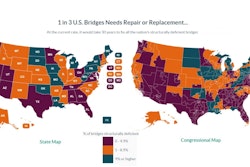
USDOT Secretary Buttigieg unveiled the National Roadway Safety Strategy (NRSS) and said the USDOT would provides “concrete steps” for the agency to address an “alarming rise” in roadway fatalities via “systemic changes” to prevent these “tragic and avoidable deaths and serious injuries.”
To complement the strategy, the Federal Highway Administration has released new guidance to implement changes in its signature highway safety funding program, which received substantial new funding under President Biden’s Bipartisan Infrastructure Law (BIL). Under the BIL, Highway Safety Improvement Program funding from 2022 to 2026 will increase significantly to $15.6 billion.
The guidance ensures that the new funds are used strategically to make travel safer, including protecting people outside of vehicles, such as people walking, biking, or using mobility assistive devices, thereby reducing the number of lives lost on the nation’s highways, bridges and roads.
NRSS First Step Towards "Vision Zero"
Almost 95 percent of our Nation’s transportation deaths occur on America’s streets, roads and highways, and these numbers are on the rise. An estimated 38,680 people died in motor vehicle crashes in 2020. In the first half of 2021, an estimated 20,160 people died, up 18.4 percent compared to the first six months of 2020.
"Every year, millions more are seriously and often permanently injured," Buttigieg says. "Those lost are our family members, our friends, our colleagues, our neighbors. They are the people who build, maintain and fix our roads. They are the people who deliver critical goods, and those who risk their own lives to keep us safe."
The NRSS describes the major actions the USDOT will take to make a meaningful difference in road safety over the next few years. At the core of this strategy is a Department-wide adoption of the Safe System Approach, which focuses on five key objectives: safer people, safer roads, safer vehicles, safer speeds, and post-crash care. The DOT says new programs will be launched to accomplish this as well as improved existing programs, and an adoption of a foundational set of principles to guide this strategy.
Some of the key actions USDOT expects to take in regards to the NRSS include:
- Work with states and localities to build and maintain safer roadway via updates to the Manual on Uniform Traffic Control Devices or MUTCD. [Editor’s note: The Federal Highway Administration has been attempting to update the MUTCD since December 2020, an effort AASHTO and other transportation groups have urged the agency to speed up.]
- Deploying a national “Complete Streets” initiative to provide technical assistance to communities of all sizes as well as setting lower speed limits. [Several state departments of transportation are already adopting “Complete Streets” plans on their own, such as in California and South Carolina.]
- Leveraging technology to improve the safety of motor vehicles on our roadways, including new rulemaking to mandate automatic emergency braking and pedestrian automatic emergency braking, while updating to the New Car Assessment Program.
- Increasing road safety investments via funding from the $1.2 trillion Infrastructure Investment and Jobs Act signed into law in November 2021. That law includes a new $6 billion “Safe Streets and Roads for All” program, hundreds of millions for behavioral research and interventions, and $4 billion in additional funding for the Highway Safety Improvement Program.
Increased Funding Prioritizes Safety Efforts
After the NRSS was announced, the FHWA issued guidance and outlined several changes to its Highway Safety Improvement Program (HSIP) to help state, local and tribal transportation agencies save lives on the roads and bridges they own and operate.
The HSIP is one of the most important federal programs for transportation agencies in their efforts to protect all road users, and the BIL bolsters it with an infusion of additional funds. HSIP funding levels from 2016 to 2020 under the Fixing America’s Surface Transportation (FAST) Act totaled $11.5 billion. Under the Bipartisan Infrastructure Law, HSIP funding from 2022 to 2026 will increase significantly to $15.6 billion.
“FHWA’s goal is to help state and local transportation agencies across the country deliver projects that make streets, highways, and bridges safe and accessible for all users,” said Deputy Federal Highway Administrator Stephanie Pollack. “Under the President’s Bipartisan Infrastructure Law, states now have more flexibility and funding to make highway safety improvements.”
Consistent with the NRSS, FHWA recommends that HSIP funds be used to incorporate a more data-driven, holistic and equitable Safe System Approach to roadway safety that builds in redundancies so if one element of a transportation system fails, other elements provide protection to save lives and prevent serious injuries on our roads.
The HSIP places a focus on infrastructure safety improvements, and under the BIL, states now have more flexibility to use up to 10 percent of their HSIP funds for “specified safety projects” that include non-infrastructure safety projects such as public awareness campaigns, research, automated traffic enforcement systems, emergency services, and efforts to protect children such as Safe Routes to School activities.
The FHWA guidance issued also implements the provisions of the BIL that will help vulnerable road users who are considered to be most at risk for being involved in traffic crashes that result in fatalities. These road users include people who walk, bike, and use personal conveyances. To protect them, the new law adds a Vulnerable Road User Safety Special Rule to the HSIP. Under the rule, if vulnerable road users make up 15 percent or more of the total number of fatalities in a state in a given year, the state is required to dedicate at least 15 percent of its HSIP funds the following fiscal year to projects that address the safety of these road users. Additionally, the new guidance incorporates legislative changes to permit 100% Federal funding for certain pedestrian and bicyclist projects.




















